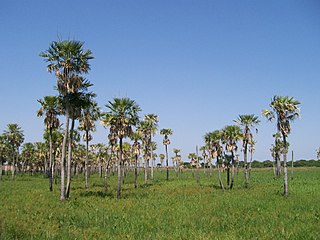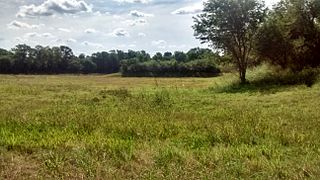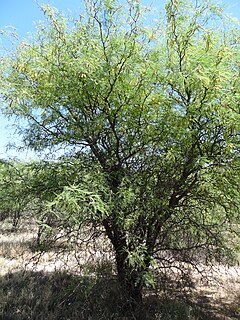Related Research Articles
Mesquite is a common name for several plants in the genus Prosopis, which contains over 40 species of small leguminous trees. They are native to dry areas in the Americas. They have extremely long roots to seek water from very far under ground. As a legume, mesquites are one of the few sources of fixed nitrogen in the desert habitat. These trees bloom from spring to summer. They often produce fruits known as "pods". Prosopis spp. are able to grow up to 8 m tall, depending on site and climate. They are deciduous and depending on location and rainfall can have either deep or shallow roots. Prosopis is considered long-lived because of the low mortality rate after the dicotyledonous stage and juveniles are also able to survive in conditions with low light and drought. The Cahuilla indigenous people of western North America were known to eat the seeds of mesquite.

Prosopis is a genus of flowering plants in the family Fabaceae. It contains around 45 species of spiny trees and shrubs found in subtropical and tropical regions of the Americas, Africa, Western Asia, and South Asia. They often thrive in arid soil and are resistant to drought, on occasion developing extremely deep root systems. Their wood is usually hard, dense and durable. Their fruits are pods and may contain large amounts of sugar. The generic name means "burdock" in late Latin and originated in the Greek language.

Chaco, officially the Province of Chaco, is one of the 23 provinces in Argentina. Its capital and largest city, is Resistencia. It is located in the north-east of the country.

The Gran Chaco or Dry Chaco is a sparsely populated, hot and semiarid lowland natural region of the Río de la Plata basin, divided among eastern Bolivia, western Paraguay, northern Argentina, and a portion of the Brazilian states of Mato Grosso and Mato Grosso do Sul, where it is connected with the Pantanal region. This land is sometimes called the Chaco Plain.

The Paraguayan Chaco or Región Occidental is a semi-arid region in Paraguay, with a very low population density. The area is being rapidly deforested. Consisting of more than 60% of Paraguay's land area, but with less than 10% of the population, the Chaco is one of the most sparsely inhabited areas in South America.

The Wichí are an indigenous people of South America. They are a large group of tribes ranging about the headwaters of the Bermejo River and the Pilcomayo River, in Argentina and Bolivia.

The Chaco National Park is a national park of Argentina, located in the province of Chaco. It has an area of 150 km2. It was created in 1954 in order to protect a sample of the Eastern Chaco, composed mainly of warm lowlands, with an annual summer rainfall between 750 and 1,300 mm.

Prosopis alba is a South American tree species that grows in central Argentina, the Gran Chaco ecoregion, and part of the Argentine Mesopotamia, as well as Bolivia, Paraguay, and Peru. It is known as algarrobo blanco in Spanish, which means "white carob tree". Spanish settlers gave it that name because of its similarity to the European carob tree. Other common names come from Guaraní, including ibopé and igopé.

Prosopis nigra is a South American leguminous tree species that inhabits the Gran Chaco ecoregion, in Argentina and Paraguay. It is known as algarrobo negro in Spanish, which means "black carob tree". It is also variously called algarrobo dulce, algarrobo morado and algarrobo amarillo.

The Argentine Northwest is a geographic and historical region of Argentina composed of the provinces of Catamarca, Jujuy, La Rioja, Salta, Santiago del Estero and Tucumán.

The Humid Chaco is tropical grasslands, savannas, and shrublands ecoregion in South America. It lies in the basin of the Paraná River, covering portions of central Paraguay and northern Argentina, and with a small portion extending into southwestern Brazil. The natural vegetation is a mosaic of grasslands, palm savanna, and forest.

Guaycuru or Guaykuru is a generic term for several ethnic groups indigenous to the Gran Chaco region of South America, speaking related Guaicuruan languages. In the 16th century, the time of first contact with Spanish explorers and colonists, the Guaycuru people lived in the present-day countries of Argentina, Paraguay, Bolivia, and Brazil.
Pilagá is a Guaicuruan language spoken by 4,000 people in the Bermejo and Pilcomayo River valleys, western Formosa Province, in northeastern Argentina.

Prosopis kuntzei is a South American leguminous tree species that inhabits the westernmost Gran Chaco forests covering areas of Argentina, Bolivia, and Paraguay, where it acts as natural component. It has also been able to colonize the nearby pasture sabanas. It is commonly referred to as itín, palo mataco, carandá or barba de tigre. It is adapted to arid climate, but can also survive flooded ground for a long time.
The Environment of Argentina is characterised by high biodiversity.

Mesorhizobium is a genus of Gram-negative soil bacteria. At least one, the nitrogen fixing species, Mesorhizobium loti, forms symbiotic root nodules with plants in the genus Lotus. Strain MAFF303099 of M. japonicum has been fully sequenced.

Capsicum chacoense is a species of the genus Capsicum native to South America. While it is rarely cultivated by humans, it, like domesticated Capsicum species, produces edible fruit.

Solanum chacoense is a species of wild potato. It is native to South America, where it can be found in Brazil, Bolivia, Argentina, Peru, Uruguay, and Paraguay. It "is one of the most widely distributed wild potato species." It grows as a common weed in disturbed habitat such as crop fields. It can also be found in Australia, China, the United States, England, New Zealand, and elsewhere as an introduced species.

Prosopis flexuosa, commonly known as tortuous mesquite and a variety of Spanish vernacular names including algarrobo dulce and algarrobo negro, is a species of flowering tree in the genus Prosopis of the family Fabaceae. It is found in arid and semi-arid regions of Argentina, Bolivia and Chile, including the western Gran Chaco and the Monte Desert, where it is a conspicuous and characteristic plant of the region. Its timber is used for construction, charcoal and fuel and its fruits are eaten by humans and livestock.

The espinal (NT0801) is an ecoregion of dry, thorny forest, savanna and steppe in Argentina. It has been extensively modified by large scale cattle ranching, but remnants of the original flora remain. It is threatened by the advance of the irrigation-based agricultural frontier.
References
- ↑ LSPN lpsn.dsmz.de
- ↑ Straininfo of Mesorhizobium chacoense
- ↑ Velázquez, E; Igual, J. M.; Willems, A; Fernández, M. P.; Muñoz, E; Mateos, P. F.; Abril, A; Toro, N; Normand, P; Cervantes, E; Gillis, M; Martínez-Molina, E (2001). "Mesorhizobium chacoense sp. nov., a novel species that nodulates Prosopis alba in the Chaco Arido region (Argentina)". International Journal of Systematic and Evolutionary Microbiology. 51 (Pt 3): 1011–21. doi: 10.1099/00207713-51-3-1011 . PMID 11411668.
- ↑ Deutsche Sammlung von Mikroorganismen und Zellkulturen
- ↑ UniProt